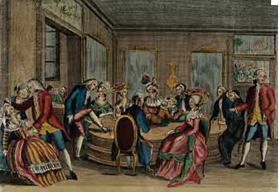Mesmeric and Symbolical Method
The method elaborated by F. A. Mesmer allows healing to take place quite rapidly, especially when a group is formed and symbols are utilized. In the last-mentioned instance, the operator becomes a conduit pipe to channel this energy. In fact from the moment we were born, we adapted to social pressures. Being in an harmonical group can be very powerful. Even people that don’t react to other methods will indeed change and transform themselves. By resorting to the mesmeric method, the operator establishes himself as the vehicle of a force. In addition to the aforesaid, symbols and other elements are used to further enhance the results harvested thereby. Besides creating an environment which is more apt to produce a healing, a group likewise gives birth to a kind of energy field. Consciousness of the members get changed in a joint fashion. The group can reate what is called an “egregore”, that is, a form-thought with an intrinsic capacity to facilitate healing, which subsequently produces an impact on the individual subject as well. It is only possible to give an effective explanation of the said phenomenon by examining quantum disciplines. Coherent concentration of attention is capable of modifying the ondulatory fields that are the basis of our explicate reality. If more people act and think coherently results are enhanced. A group is moreover able to help the single persons who comprise it to learn on their own how to develop their potentialities. That explains why, even today, courses and assemblies can act as powerful tools of effecting healing and improvement. Through the invention of the bacquet, a kind of focal point for the group’s attention, Mesmer was able to create a group condition which was extremely conducive to healing, in so doing anticipating psychological concepts which only in recent times have been understood within the medical fraternity. In fact baquet usefulness under a proper guide is even sound plain psychology. For many centuries, no importance whatsoever had been assigned to the environment as a healing factor, and the dominant thought was that hospitals had to be extremely serious and essentially sad places where laughing was disallowed. This thought was shared among others by Paulet, a contemporary of Mesmer, who deemed it right to scorn him. If we, however, read what Mesmer wrote and interpret it in the light of current knowledge, we will realize that he had been an innovator awake to the fact that well-being descends on sick people when they are placed in a healthy and inspiring environment where they can find themselves again.


Comparison between a mesmeric environment (on the left) and the medical environment which characterized Mesmer’s age (on the right)
A telling element is the great number of Mesmer’s contemporaries who failed to realize the extent to which the right environment might facilitate healing, though our days it is a concept taken for granted. Paulet wrote the following: “In actual fact, should we not regard these assemblies of brilliant personalities, and this buzz that, night and day, reigns unchallenged in the place where Mr. Mesmer operates, as being superior? If we were to compare such incessant motion with these gatherings of Doctors, these speechless consultations, which resemble meditations on the subject of death, who would have any doubt as to which of the two he should choose? On the one hand we have wonderment and effect, whereas, on the other hand, we get obscure or sinister concepts, a cluster of frightening medical tools, and Latin words which are unknown to most people. We get ominous looks cast by men clad in black upon a dismayed patient, along with black-coloured disgusting concoctions the sick man is called upon to swallow.
The name Mesmérisme for indicating the techniques of Animal Magnetism was first used in France. Soon this term spread in every country where the technique was practiced as a synonym of animal magnetism. Wolfart used the name "Mesmerism" for his book containing Mesmer's system. A tendency emerged amongst British magnetizers to call their clinical techniques mesmerism;. the term was used even by some of them who distanced themselves from the theoretical orientation of animal magnetism that was based on the concept of "magnetic fluid". At the time, some magnetizers attempted to channel what they thought was a magnetic "fluid"; and, sometimes, they attempted this with the "laying on of hands". Reported effects included various feelings: intense heat, trembling, trances, and seizures.
Here by Mesmer, conversely, a doctor wearing a purple to violet dress over which [as per the fashion of the day: Editor’s note] images of the most brilliant flowers are brocaded [1] is busy comforting his female patient by uttering pleasantly sounding words; he lends him support amid the spasms that shake her, and his eye gives explicit voice to his desire to help her. The horrific [and, given the epoch, suspicious] pharmaceutical specialties are put aside, whereas a wave replaces sheer poison, and the ability to bring it to the person attains the result sought by it”. Viewed through today’s lenses, we can easily recognize the fact that Mesmer’s attitude was the more correct of the two. Other than through the sick patients’ eyes, however, that was not the way his age looked at the matter. Mesmer, indeed, was instrumental for curing many a patient, and, as a challenge, he promoted the idea of testing a sample of patients by subjecting them to treatment by both his method and the one ordinarily used by doctors, so as to verify which one would be able to produce the greatest benefit. But the academy didn’t accept this kind of comparatory challenge. Mesmer let anyway descriptions of his successful results. Naturally, Mesmer treated patients on an individual basis as well. His methodology is quite comprehensive, as it works on specific plexuses of the body in conformity with a precisely delineated technique, albeit one which was extensively based on the operator’s intuitive abilities.
